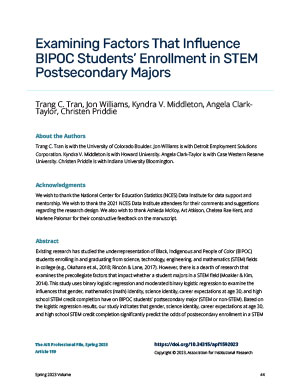The AIR Professional File
Spring 2023, Article 160
Examining Factors That Influence BIPOC Students’ Enrollment in STEM Postsecondary Majors
https://doi.org/10.34315/apf1602023Abstract
Existing research has studied the underrepresentation of Black, Indigenous and People of Color (BIPOC) students enrolling in and graduating from science, technology, engineering, and mathematics (STEM) fields in college (e.g., Okahana et al., 2018; Rincón & Lane, 2017). However, there is a dearth of research that examines the precollegiate factors that impact whether a student majors in a STEM field (Moakler & Kim, 2014). This study uses binary logistic regression and moderated binary logistic regression to examine the influences that gender, mathematics (math) identity, science identity, career expectations at age 30, and high school STEM credit completion have on BIPOC students’ postsecondary major (STEM or non-STEM). Based on the logistic regression results, our study indicates that gender, science identity, career expectations at age 30, and high school STEM credit completion significantly predict the odds of postsecondary enrollment in a STEM major. In addition, our ad hoc analysis confirms that gender moderates the relationship between science identity and the likelihood of a STEM collegiate major. These results can aid researchers and practitioners in investigating opportunities to improve STEM participation for BIPOC students.
Keywords: STEM identity; STEM career expectation; math and science credit completion; STEM enrollment
Authors
- Trang C. Tran
- Jon Williams
- Kyndra V. Middleton
- Angela Clark-Taylor
- Christen Priddie
Acknowledgements
We wish to thank the National Center for Education Statistics (NCES) Data Institute for data support and mentorship. We wish to thank the 2021 NCES Data Institute attendees for their comments and suggestions regarding the research design. We also wish to thank Ashieda McKoy, Art Atkison, Chelsea Rae Kent, and Marlene Palomar for their constructive feedback on the manuscript.
Copyright © Association for Institutional Research 2023

